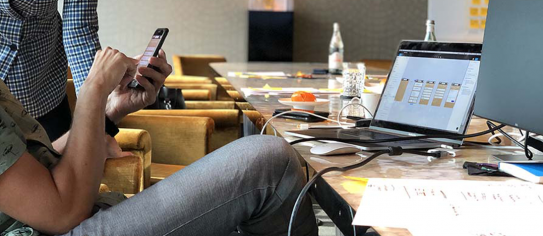
5 Day Value-driven Design Sprint
A value-driven design sprint from the client's view: “a new business model in five days”. Learn more about the Spirit Hospitality Services case.
Read more about our Value Driven Design Spint in our dedicated page ➔
Today, as offices remain largely empty and companies are looking to create welcoming places for their employees to meet, Spirit Hospitality Services’ job is changing. The big question is whether reception services will continue to exist in their current form and which new services will help large companies in finance and insurance, for instance, to meet the future. “Although things were going well, COVID-19 has been a catalyst inspiring us to speed the change”, says Daniëlle Schoeman, Sales & Operations manager at the company.
Spirit started a value-driven design sprint with an open mind and zero expectations about the outcome. Partly based on Google's design method, a value-driven sprint provides a framework for tackling major problems or challenges in just four (or five) days. Under the guidance of SQLI, a team of involved Spirit employees was given the freedom to explore new directions and validate assumptions. Then from inside this pressure cooker of a brainstorming session, they develop an initial concept or prototype. So, while you as a company may have no idea where exactly where it’s heading, you always end up in a good place. “A design sprint provides interesting answers”, Schoeman now knows. “While it’s an investment in the future, it’s also a technique that delivers immediate results”.

Day 1: From kick-start to clear target
Prior to the first sprint day, a brainstorming session was organised with Spirits employees from the floor. After all, they’re the eyes and ears of the organisation: What do they see as the main challenge? In addition, five customer interviews provided some initial insights. Combined, this provides the necessary guidance for later determination of the focus of the sprint.
The first day of the value-driven design sprint focused on a clear and empathic problem definition. What does the world look like? Where do those involved see pain points and opportunities? Strikingly enough, there was a large overlap with the insights from the interviews. The new mass working from home and the changing role of the office are actually leading to a great loss. As an employee, it makes it harder to identify with an employer. And those who do come to the office find there’s little sense connection. It’s also as if nobody really feels responsible for the physical workplace and what happens between the office walls.
By holding all kinds of workshops individually and in the group, a major problem was gradually given a clear scope. Part of this was that Spirit employees’ new ideas were constantly being challenged by the SQLI consultants for their creativity and feasibility “That may seem a bit contradictory”, says Schoeman. "But you don't want to spend days building a castle in the sky”. Finally, one pre-designated decision-maker was given the task of choosing which challenge they would fully zero in on that week. This resulted in a new goal for Spirit: to be the market leader in the area of guest and employee experience within five years.
Day 2: Dozens of solutions
Even though the first day was intensive, it also generated an enormous amount of energy. The challenge was to then turn enthusiasm into concrete solution proposals. The various exercises successfully helped with this conversion. One exercise Schoeman remembers was the “crazy 8”, where everyone sketches out as many mini concepts as possible for eight minutes. Of course, this doesn’t have to be a detailed or even a “good” development. The aim is to silence the critical thinking and create room for creativity. “It yielded over one hundred suggestions.”
All the ideas that come up are written down - on post-its, for example - and put together, they form a museum of new concepts. Once the plans have been collected, everyone votes for the favourites. The decider, in this case, Spirits managing director Joyce Visser, then selected a few elements to work out a final concept. “An app that uses data to show how well the employees of Spirits customers are doing – the employee experience - seemed to be the most promising approach”. Nevertheless, they ultimately decided that this value should be pursued more broadly. "An app can be a tool, but ideally it should be part of our broader pitch”.

Day 3: The elaboration
Under the concept name “The Experience Super Star”, or TESS for short, a pitch document was elaborated and a prototype of the app was developed. Together they form a marketable service. Within this concept, the receptionists - already visibly present on the office floor - turn into the ears and eyes of every customer. By going out onto the work floor, they relieve employees who use the office space in its new form and monitor how things are going within the office using the TESS app. They take responsibility for matters that remain in place today. Spirit focuses on four pillars:
- Incidents, including technical defects, are recorded in the app;
- The client's own observations and proactive suggestions are recorded;
- Receptionists map out employee satisfaction based on their connection with employees;
- Finally, they are the point of contact for questions and information and provide the necessary information.
Every client can now count on push notifications about reports that provide relevant insights into what is happening on the shop floor. Just like a satisfaction analysis, broken down by location or department.

Day 4: Pitching
A week later, in which the digital prototype of the app was developed in the background, on the fourth day, the pitch presentation of the overall concept was put front and centre. The first set of clients received a six-minute pitch, validating the new concept of TESS and the app. The resulting minor refinements were incorporated into an improvement and roll-out plan.
"Eighty per cent were so enthusiastic that they made a follow-up appointment to pitch the idea to other colleagues in the organisation. For one company, our vision of the future turned out to be the key piece of the puzzle in awarding us a tender. Another client immediately saw in us the sounding board they’d been looking for”, says Schoeman. The differences in responses were mainly due to the progressive nature of the companies themselves. "Some haven’t had the opportunity to form a vision of the new way of working from home yet. We immediately noticed that improving the employee experience takes a great deal of input”.
Day 5: Involvement
This last and fifth day focused on the involvement of Spirit's headquarters. Employees who don’t yet know the outcome of the design sprint must of course also be brought on board.
“By going through all the steps taken previously at a central time, identifying the trade-offs and sharing the outcome, we were all on the same page”, remarked Schoeman. “Having this common goal clearly motivates us to explore a new direction and then to improve and roll out the concept together. For example, a plan to take over the onboarding of new employees is now on the roadmap”.
What a value-driven design sprint makes clear time and again is how well a “pressure cooker” works. Under the proper guidance of an independent party and with mutual purpose, you nurture an open and honest atmosphere. This dynamic creates a spirit of trust in questioning each other critically. In five days, Spirit will have a newly developed concept and business model created in-house. This year, the company will launch a first pilot, after which more companies will be offered this service for the guest and employee experience. Says Schoeman: "The design sprint felt like a leap into the unknown, but one with real results. It’s been the kick-start that’s driving our company forward today".
Did we pique your interest?
Get in touch to discuss how we can drive your digital success.
Contact Us


